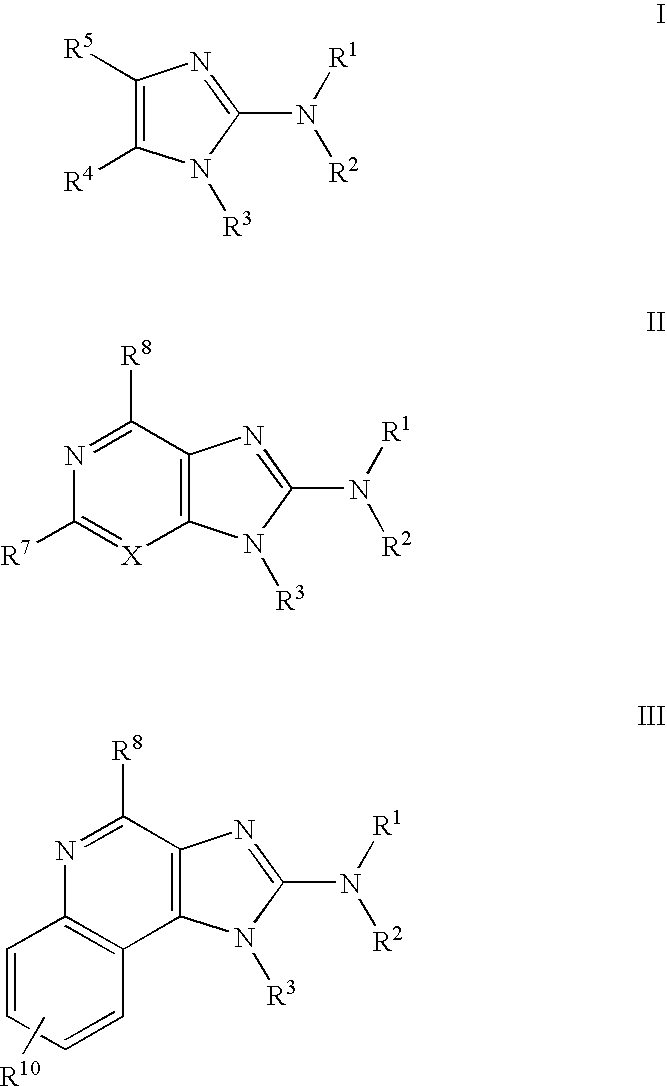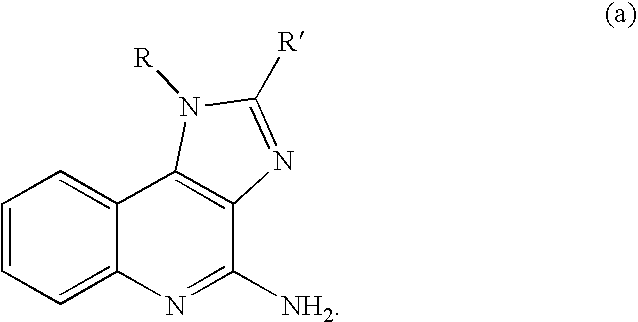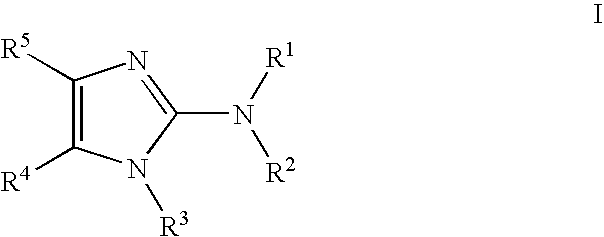Methods for the preparation of imidazole-containing compounds
- Summary
- Abstract
- Description
- Claims
- Application Information
AI Technical Summary
Benefits of technology
Problems solved by technology
Method used
Image
Examples
example 1
General Routes for Preparation of Compounds According to the Methods of the Invention
[0618]Schemes I, II and III, below, describe the preparation of some preferred compounds according to the methods of the invention.
[0619]In accordance with Scheme 1, quinoline-2,4-diol 1 is nitrated with nitric acid in acetic acid to yield 3-nitroquinoline-2,4-diol 2. Chlorination with phenylphosphonic dichloride yields 2,4-dichloro-3-nitroquinoline 3. Reaction with 2-methylaminoisopropylalcohol yields 2-chloro-3-nitro-4-(2-hydroxy-2-methyl-propylamino) quinoline 4. Subsequent reduction of the nitro group provides the corresponding 3,4-diamino compound 5. Reaction of 5 with a dichloro immonium compound of general formula Cl2C═N(R′)(R″), prepared from the reaction of ClC(═S)N(R′)(R″) with diphosgene, yields the substituted 4-chloroimidazoquinoline 6. Displacement of halogen with hydrazine or azide yields the corresponding hydrazide or azide 7, and subsequent reduction provides the final amino compoun...
example 2
3-nitroquinoline-2,4-diol
[0624]
[0625]The title compound was prepared following methods described by Buckle, Derek R.; Cantello, Barrie C. C.; Smith, Harry; Spicer, Barbara A. 4-Hydroxy-3-nitro-2-quinolones and related compounds as inhibitors of allergic reactions. Journal of Medicinal Chemistry 1975, 18(7), 726-32, incorporated herein by reference in its entirety.
[0626]In a 500 mL round bottom flask was added quinoline-2,4-diol (16.2 g, 0.1 mol) followed by glacial HOAc (100 mL, 1.74 mol) and HNO3 (70%, 26 mL, 0.4 mol). The reaction remained a suspension and thickened to the point where stirring was not possible. The liquid portion was dark brown and the solid appeared off-white at this time. The reaction vessel was fitted with a reflux condenser (securely clipped), placed in an oil bath (105° C.) and rotated slowly by hand for ˜5-8 minutes at which point the off-white solid completely dissolved (dark brown liquid). Heating / rotation was continued and a yellow solid began to form (˜3...
example 3
2,4-dichloro-3-nitroquinoline
[0627]
[0628]The title compound was prepared following procedure outlined by Izumi, Tomoyuki; Sakaguchi, Jun; Takeshita, Makoto; Tawara, Harumi; Kato, Ken-Ichi; Dose, Hitomi; Tsujino, Tomomi; Watanabe, Yoshinari; Kato, Hideo. 1H-Imidazo[4,5-c]quinoline derivatives as novel potent TNF-α suppressors: synthesis and structure-activity relationship of 1-, 2- and 4-substituted 1H-imidazo[4,5-c]quinolines or 1H-imidazo[4,5-c]pyridines. Bioorganic & Medicinal Chemistry 2003, 11(12), 2541-2550, incorporated herein by reference in its entirety.
[0629]3-Nitroquinoline-2,4-diol (13.4 g, 65 mmol) and phenylphosphonic dichloride (41 mL, 260 mmol) were combined at room temperature under nitrogen and then heated to 140° C. for 3 hours. The mixture was poured into ice water and stirred vigorously for 30 minutes, and filtered to capture the solid formed. The solid was rinsed twice with water and then dried overnight under vacuum to provide 2,4-dichloronitroquinoline (13.2 g...
PUM
 Login to View More
Login to View More Abstract
Description
Claims
Application Information
 Login to View More
Login to View More - R&D
- Intellectual Property
- Life Sciences
- Materials
- Tech Scout
- Unparalleled Data Quality
- Higher Quality Content
- 60% Fewer Hallucinations
Browse by: Latest US Patents, China's latest patents, Technical Efficacy Thesaurus, Application Domain, Technology Topic, Popular Technical Reports.
© 2025 PatSnap. All rights reserved.Legal|Privacy policy|Modern Slavery Act Transparency Statement|Sitemap|About US| Contact US: help@patsnap.com



